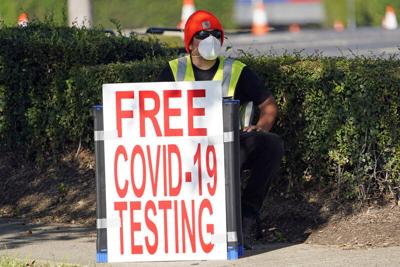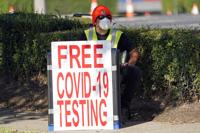NEW YORK – U.S. health officials sparked criticism and confusion after posting guidelines on coronavirus testing from the White House task force that run counter to what scientists say is necessary to control the pandemic.
The new guidance says it's not necessary for people who don't feel sick but have been in close contact with infected people to get tested. It was posted earlier this week on the website of the U.S. Centers for Disease Control and Prevention.
The CDC previously had advised local health departments to test people who have been within 6 feet of an infected person for more than 15 minutes. But on Monday, a CDC testing overview page was changed to say that testing is no longer recommended for symptom-less people who were in close contact situations.
There was a caveat, however. Testing may be recommended for those with health problems that make them more likely to suffer severe illness, or if their doctor or local state officials advise they get tested.
Across the country, public health experts called the change bizarre. They noted that testing contacts of infected people is a core element of public health efforts to keep outbreaks in check, and that a large percentage of infected people – the CDC has said as many as 40% – exhibit no symptoms.
“The recommendation not to test asymptomatic people who likely have been exposed is not in accord with the science,” said John Auerbach, president of Trust for America's Health, a nonprofit that works to improve U.S. preparedness against disease.
Some – including at least two state governors – said it was another sign of a dysfunctional federal response to the pandemic.
“This is like a public health version of Vietnam,” said Brian Castrucci, president and CEO of the de Beaumont Foundation, which works to strengthen the public health system.
After Twitter lit up with head-scratching and alarm about the change, officials with the U.S. Department of Health and Human Services sent an email Wednesday saying the guidance was revised “to reflect current evidence and the best public health interventions,” but did not detail what the new evidence was.
The decision came out of meetings of the White House coronavirus task force, HHS officials said.
Ultimately, restricting testing could be self-defeating, because it could skew the numbers and create a perception that rates of infection are higher. Testing people who appear to be healthy would tend to lower the overall rate of positive results, while narrowing testing to people who are sick would raise the overall positive rate, Auerbach said.
Dr. Brett Giroir, the HHS assistant secretary for health, said the change in guidance was passed by consensus by the White House task force without input from Trump or Vice President Mike Pence.
“There was no weight on the scales by the president or the vice president” or HHS Secretary Alex Azar, Giroir said.




